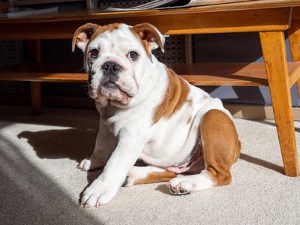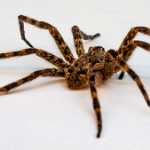Bulldog puppies are so cute, aren’t they? You feed them, you cuddle them, yet by the time they get to 10 weeks or so you start noticing something strange.
In a previous post I wrote about French Bulldogs with long legs, which has generated a lot of interest from owners of bulldogs with long legs…
Are your pet’s legs getting longer than they should or is it just your imagination? The answer is no, it’s not just your imagination, some bulldogs do grow taller than the average for their breed and there are several reasons why this happens.
Why do some bulldogs have long legs?
When a dog owner discovers his new pet bulldog has long legs he normally wonders why? Was the breeder where he got the dog dishonest and the dog is not purebred? Yes, such things have been known to happen and it should not come as a surprise. Bulldogs have been intensely crossbred to eliminate certain features or to enhance others.
On the other hand, your dog’s long legs may be due to genetics only. It is a well-established fact that even the same pairing of dogs can produce litters with different features. Just like humans, dogs inherit two sets of genes – one from the mother and one from the father. How the puppy looks depends on these genes and it can very well be that the odd long legs that your bulldog has were inherited not from the parents, but from distant grand-grand-parents. The same goes for other features like nose length, head size, or coat color.
Which types of Bulldogs are known to have long legs?
All bulldog types that exist today can be traced back to the bulldogs that were once used in England to guard livestock and for the bloody practice of bull-baiting, which was outlawed in 1835. After that point, breeders looked to preserve the Bulldog species and eliminate the aggressiveness of the dogs.
However, those dogs used for bull baiting were more athletic than today’s bulldogs, those with short legs and a characteristic shuffling gait. Selective breeding transformed those larger and aggressive dogs into the gentle pets so popular today.
There are three main bulldogs types today:
- English Bulldog
- American Bulldog
- French Bulldog.
However, there are many other local subtypes, the result of various selective breeding processes.
American Bulldogs are taller than English Bulldogs
If you consider the English purebred as representative for the species, the American type can be distinguished by its long legs.
After bull baiting was outlawed, some immigrants managed to bring the hard-working Olde English bulldog to the US where it was put to work around the farms.
The American Bulldog type we know today was created by two breeders Allan Scott and John D. Johnson who worked together for some time, before parting ways as they had different views on the desirable traits in a bulldog.
Today, the American Bulldog type includes two subtypes: the Scott and the Johnson bulldog. While the Johnson American Bulldog resembles the English Bulldog, the Scott American Bulldog is sleeker, taller, and more athletic. His legs are set under the body and they don’t curve to the outside like in more traditional bulldogs, including the Johnson American Bulldogs.
A Scott American Bulldog will grow up to be between 22 and 27 inches tall as the shoulders. You can easily recognize a Scott American Bulldog by its pure white coat, whereas the Johnson type has patches of red, brown, or black.
A Johnson American Bulldog is roughly the same height, but it is a more massive dog with heavy bones.
The Olde English Bulldogge, an American breed recognized in 2014 is also taller than the standard English Bulldog, standing at up to 19 inches at the shoulders.
Australian Bulldogs are very similar in temperament and appearance to the English Bulldogs and stand up to 20 inches tall.
Buldogue Campeiro, the Brazilian bulldog is a farm animal, and definitely not the gentle type like the common household pet. These dogs are between 19 and 23 inches tall.
Ca de Bou is a Spanish breed originally from the island of Majorca and it’s a crossbreed between bulldogs and mastiffs. The Spanish bulldog is 20 to 23 inches tall.
The Continental Bulldog, recognized in some European countries since 2005 is also a more athletic crossbreed that is slightly taller than the English Bulldog.
How tall should a purebred English bulldog be?
The purebred English bulldog, also called simply bulldog, is a medium-sized dog weighing between 40 and 50 pounds. Its front legs may be straight or slightly out-turned, with the elbow standing out from the body. The hind legs are definitely curved outward.
The male English Bulldog is approximately 15 inches tall, while the female is around 14 inches tall.
How long should a Bulldog be?
An English Bulldog is between 20 and 27 inches long when it reaches maturity. This refers to the dog’s length from snout to tail. However, bulldogs are known for their massive heads. Measured from neck to tail an English Bulldog is between 12 and 16 inches long.
When do bulldogs stop growing?
Smaller breeds mature quicker than larger ones. As far as English Bulldogs are concerned, they are considered mature when they reach 12 months of age, while the American Bulldog matures at two years old.
Here is an interesting fact – English Bulldogs typically reach their adult height (14-15 inches) at one year, but in terms of weight and muscle mass, they will continue to grow for the next six months.
They reach the adult weight of approximately 50 pounds soon after turning one. Owners need to pay attention to their bulldog’s weight. This type of dog is less energetic and requires less exercise than other breeds. However, they do need some exercise as they are prone to obesity. As their short snouts cause breathing problems and they’re unable to cool off as easily as other dogs, bulldogs should not be forced to exercise on hot days.
During their growth period, bulldogs require a lot of protein to develop the broad stance and wide shoulders they’re famous for. Keep in mind that a bulldog will continue to fill out until he reaches 18 months of age.
If they reach physical maturity between 12 and 18 months, from an emotional point of view they continue to develop until the age of three years. During this period they require careful socializing and positive experiences.
What are the most popular types of Bulldogs?
The English Bulldogs and the French Bulldogs are by far the most popular types of bulldogs, mainly due to their funny faces and gentle temperament. They make excellent pets as they are very playful, especially the Frenchies, and fiercely loyal to their human family.
Unfortunately, these two breeds are also the most prone to health problems as a result of selective breeding. As the public adores these dogs with an infantile appearance, breeders did their best to come up with desirable animals, even though these cultivated features contribute to poor quality of life and a reduced lifespan.
Over the past decades, English and French bulldogs have been bred to have flat faces with extremely short snouts which cause various respiratory problems.
Bulldogs also suffer from hip dysplasia at a higher rate than other breeds of the same size. Hip dysplasia is a genetic disease that usually affects large breeds of dogs. It is considered primarily a disease of purebreds, although it can also occur in mixed breeds.
One study from the Orthopedic Foundation for Animals indicates that over 70% of bulldogs suffer from hip dysplasia, the highest percentage among all breeds considered. This causes locomotion problems for the poor animals. As the disease progresses the dog struggles to walk and develop a sort of bunny-hop which might seem funny, but the truth is the dog suffers from stiff joints and pain in the affected leg. Eventually, the dog starts to limp and will refuse exercise or even taking part in activities he once enjoyed. This is the direct result of selective breeding to make the animal have shorter outward bent limbs. In this respect, American Bulldogs are healthier and have fewer problems.
What other breeds of dogs are bulldogs bred?
Experts say the only solution to save the bulldog is crossbreeding with other types of dogs to reduce or eliminate some of these features. Bulldogs are usually crossbred with mastiffs to produce a litter with longer and thinner legs.
The Masti-Bull is considered a giant dog as it grows up to 30 inches tall and weighs 100 pounds when it reaches maturity. Females of the breed are slightly smaller. This breed has long and strong legs, although they still experience problems with hip dysplasia. Although larger and requiring some serious training, the Masti-Bull is an excellent pet and is very good with children.
English Bulldogs can also be crossed with Labradors to create a Bullador that is up to 25 inches tall.
A Bull Jack, a cross between a bulldog and the Jack Russell Terrier, is a wonderful dog that grows up to 15 inches tall but has straight thin legs.
Crossing a bulldog with a boxer will give birth to the Bulloxer, a tall dog, up to 27 inches at full maturity.
Unfortunately, most of these crossbreeds inherit hip dysplasia problems.
Long legs are not bad!
If you’re worried that your pet bulldog is taller than he should be, you should consider that it might be better like this for the dog. The typical short outward bent legs of the standard English bulldog cause the dog mobility problems and a lot of pain in old age. Maybe the dog is not such a purebred as you thought when you bought him, maybe it’s just genetics. However, if you’re not planning to enter your pet in a dog show you have no reason for concern. Love your dog the way he is!







